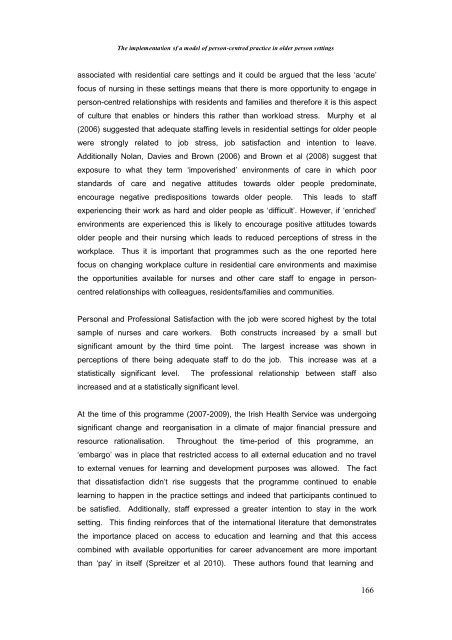The Implementation of a Model of Person-Centred Practice In Older ...
The Implementation of a Model of Person-Centred Practice In Older ...
The Implementation of a Model of Person-Centred Practice In Older ...
Create successful ePaper yourself
Turn your PDF publications into a flip-book with our unique Google optimized e-Paper software.
<strong>The</strong> implementation <strong>of</strong> a model <strong>of</strong> person-centred practice in older person settings<br />
associated with residential care settings and it could be argued that the less ‘acute’<br />
focus <strong>of</strong> nursing in these settings means that there is more opportunity to engage in<br />
person-centred relationships with residents and families and therefore it is this aspect<br />
<strong>of</strong> culture that enables or hinders this rather than workload stress. Murphy et al<br />
(2006) suggested that adequate staffing levels in residential settings for older people<br />
were strongly related to job stress, job satisfaction and intention to leave.<br />
Additionally Nolan, Davies and Brown (2006) and Brown et al (2008) suggest that<br />
exposure to what they term ‘impoverished’ environments <strong>of</strong> care in which poor<br />
standards <strong>of</strong> care and negative attitudes towards older people predominate,<br />
encourage negative predispositions towards older people. This leads to staff<br />
experiencing their work as hard and older people as ‘difficult’. However, if ‘enriched’<br />
environments are experienced this is likely to encourage positive attitudes towards<br />
older people and their nursing which leads to reduced perceptions <strong>of</strong> stress in the<br />
workplace. Thus it is important that programmes such as the one reported here<br />
focus on changing workplace culture in residential care environments and maximise<br />
the opportunities available for nurses and other care staff to engage in personcentred<br />
relationships with colleagues, residents/families and communities.<br />
<strong>Person</strong>al and Pr<strong>of</strong>essional Satisfaction with the job were scored highest by the total<br />
sample <strong>of</strong> nurses and care workers. Both constructs increased by a small but<br />
significant amount by the third time point. <strong>The</strong> largest increase was shown in<br />
perceptions <strong>of</strong> there being adequate staff to do the job. This increase was at a<br />
statistically significant level. <strong>The</strong> pr<strong>of</strong>essional relationship between staff also<br />
increased and at a statistically significant level.<br />
At the time <strong>of</strong> this programme (2007-2009), the Irish Health Service was undergoing<br />
significant change and reorganisation in a climate <strong>of</strong> major financial pressure and<br />
resource rationalisation. Throughout the time-period <strong>of</strong> this programme, an<br />
‘embargo’ was in place that restricted access to all external education and no travel<br />
to external venues for learning and development purposes was allowed. <strong>The</strong> fact<br />
that dissatisfaction didn’t rise suggests that the programme continued to enable<br />
learning to happen in the practice settings and indeed that participants continued to<br />
be satisfied. Additionally, staff expressed a greater intention to stay in the work<br />
setting. This finding reinforces that <strong>of</strong> the international literature that demonstrates<br />
the importance placed on access to education and learning and that this access<br />
combined with available opportunities for career advancement are more important<br />
than ‘pay’ in itself (Spreitzer et al 2010). <strong>The</strong>se authors found that learning and<br />
166
















